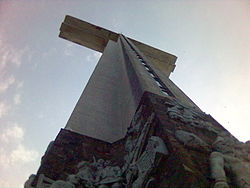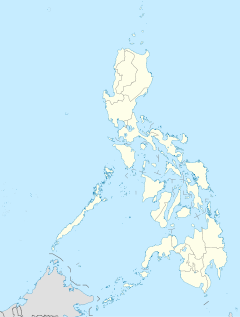- Mount Samat
-
Dambana ng Kagitingan
Memorial ShrineMount Samat Shrine Philippine Map Type Historical landmark Location Pilar, Bataan, Philippines Coordinates 14°36′20.80″N 120°30′32.17″E / 14.605778°N 120.5089361°ECoordinates: 14°36′20.80″N 120°30′32.17″E / 14.605778°N 120.5089361°E Area 73,665 hectares (182,030 acres) Created 1970 Operated by Provincial Government of Bataan Status Open year-round Dambana ng Kagitingan Memorial Cross
Shrine of Valour Memorial Cross
The Bataan Memorial CrossLocation Pilar, Bataan, Philippines Designer Lorenzo del Castillo and Napoleon Abueva Type Historical landmark Material Steel and reinforced concrete finished with chipped granolithic marble Length 90 feet (27 m) Width 18 feet (5.5 m) Height 92 metres (302 ft) Beginning date 1966 Completion date 1970 Opening date 1970 Dedicated to Soldiers who fought for freedom in the Battle of Bataan Mount Samat (Tagalog pronunciation: [samat]) is a mountain in the town of Pilar, Province of Bataan, in the Republic of the Philippines. Located on the summit of the mountain is Dambana ng Kagitingan or Shrine of Valour, a memorial shrine complex built to honor and remember the gallantry of the Filipino and American soldiers who fought during World War II.
Consisting of a colonnade and the huge Memorial Cross, the sentinel of Bataan, the park was commissioned in 1966 by then President Ferdinand Marcos, a War Veteran himself, for the 25th Anniversary of the Second World War.[1] The white Memorial Cross stands as a remembrance to the soldiers who fought and lost their lives in the Battle of Bataan. From the colonnade and the cross, one can view Bataan, Corregidor Island and on a clear day, the city of Manila. The shrine complex also includes a war museum with a wide array of collections from paintings of the Philippine heroes to armaments used by the American, Filipino and Japanese forces in the heat of the battle.
Contents
History
Along with the fortified island of Corregidor, Mount Samat was the site of the most vicious battle against the Japanese Imperial Army in 1942 during the Battle of Bataan. Suffering heavy losses against the Japanese all over Luzon, Filipino and American soldiers retreated to Bataan Peninsula to regroup for a last valiant but futile stand. This retreat to Bataan is part of a United States strategy known as War Plan Orange.
After the fierce battle lasting three days, 78,000 exhausted, sick and starving men under Major General Edward P. King surrendered to the Japanese on April 9, 1942, the Fall of Bataan. It was, and still is, the single largest surrender of U.S. soldiers ever. Together with the Philippine soldiers, they were then led on the Bataan Death March.
The scene of their last stronghold is Mount Samat, the site of the Dambana ng Kagitingan. The shrine was conceived as a fitting memorial to the heroic struggle and sacrifices of the soldiers who fought and died in that historic bastion of freedom.[2]
Architectural features
Located in an area approximately 73,665 hectares (182,030 acres), the memorial shrine complex was started in 1966 with the laying of the cornerstone on April 14, 1966 by President Marcos. The construction was not finished for the 25th Anniversary of the Fall of Bataan in 1967 due to lack of funds.[1] The shrine was completed and inaugurated in 1970 for the 25th Anniversary of the end of World War II. The park is consisted of a colonnade and at the peak of the mountain, the Memorial Cross. The shrine was designed by Lorenzo del Castillo and landscaped by Dolly Quimbo-Perez.[3]
Colonnade
From the parking lot, a wide three series of steps that narrows to the top lead visitors to the flagpole that holds the flag of the Philippines.[4] The last series of steps to the colonnade level are bordered on two sides by two pedestals topped with bronze urns symbolizing 'eternal flame.'[5]
The Colonnade is a marble-covered structure surrounded by esplanade. The esplanade is surrounded by marble covered parapets with the outer side covered with 19 high relief sculptures by National Artist Napoleon Abueva depicting images of the war alternating with 18 bronze insignias of USAFFE Division units made by Talleres de Maximo Vicente, Leonides Valdez, and Angel Sampra and Sons.[3] Each bronze insignias has a flagpole for the flags of each division.[6]
Inside the colonnade, in the middle is the altar and behind are three religious stained glass murals designed by Cenon Rivera and executed by Vetrate D'Arte Giuliani of Rome, Italy.[3] Four large chandeliers made of bronze hang from the ceiling of the building. On the two lateral walls are inscribed in marble a narrative of the “Battle of Bataan”.
Behind the Colonnade is the start of the footpath that leads to the base of the Cross.[7] The 14-flight zigzagging path on the mountain slope is paved with bloodstones from Corregidor Island. An alternate road also takes visitors to the base of the cross.[2]
Memorial Cross
The Memorial Cross is a towering structure located at the highest point of Mount Samat, 555 metres (1,821 ft) above sea level. The monument is made of steel and reinforced concrete with an elevator and viewing gallery at the arm of the cross. A staircase also take the guests to the gallery on the wings. The height of the cross is 92 metres (302 ft) from the base. The height of the arms is 74 metres (243 ft) from the base. The length of the arm is 30 metres (98 ft) (15 on each side). The viewing gallery is 18 feet (5.5 m) by 90 feet (27 m) with a 7 feet (2.1 m) clearance.[2]
The exterior of the cross is finished with chipped granolithic marble. The base up to 11 metres (36 ft) level is capped with sculptural slabs and reliefs[8] titled “Nabiag Na Bato” also by Napoleon Abueva depicting important historical figures and events like the execution of Jose Rizal[9], Lapu-Lapu[10] and Antonio Luna.[11]
Location
The complex is located in Barangay Diwa in Pilar, Bataan. Coming from Manila, head north by taking the North Luzon Expressway (Balintawak Cloverleaf) and exit at the SCTEX exit in Mabalacat, Pampanga which leads to the Subic-Clark-Tarlac Expressway. Follow the signs to Subic. Exit at the Dinalupihan exit then turn right at the Roman Highway. After about 24 kilometres (15 mi), upon reaching the Mt. Samat junction, turn west or right. After about 4.5 kilometres (2.8 mi) towards Mt. Samat, to the is a 6.5 kilometres (4.0 mi) winding uphill road to the shrine.[12]
References
- ^ a b Yu Jose, Lydia N. (2008). "The Past, Love, Money and Much More: Philippine-Japan Relations Since the End of Second World War", p.23. Ateneo de Manila University.
- ^ a b c Government of Province of Bataan (2006)."Dambana ng Kagitingan". Bataan...A Raging Peninsula. Retrieved on 2011-03-27.
- ^ a b c "Memorials in the Philippines". Filipinos World War II US Military Service. Retrieved on 2011-03-27.
- ^ rhilton4u (2009-03-09). "Memorial Steps: Mt. Samat Shrine". Flickr. Retrieved on 2011-03-27.
- ^ rhilton4u (2009-03-09). "Base Memorial: Mt. Samat Shrine". Flickr. Retrieved on 2011-03-27.
- ^ rhilton4u (2009-03-09). "Mt. Samat Shrine of Valor". Flickr. Retrieved on 2011-03-27.
- ^ rhilton4u (2009-03-09)."Mt. Samat Shrine of Valor". Flickr. Retrieved on 2011-03-27.
- ^ "Mount Samat Shrine". Flickr. Retrieved on 2011-03-15.
- ^ pianoforte (2010-03-15). "Mt. Samat Cross". Flickr. Retrieved on 2011-03-27.
- ^ pianoforte (2010-03-13). "Mt. Samat Cross". Flickr. Retrieved on 2011-03-27.
- ^ pianoforte (2010-03-15). "Mt. Samat Cross". Flickr. Retrieved on 2011-03-27.
- ^ "Mount Samat Shrine". Waypoints. Retrieved on 2011-03-21.
External links
Wikimedia Foundation. 2010.

